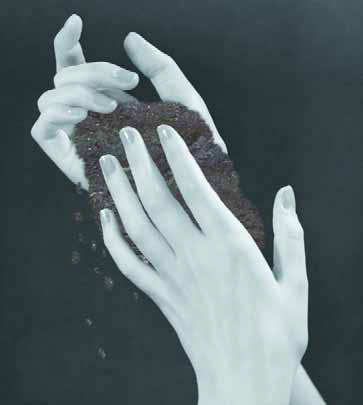composition
As a sculptor, I always seek ways to use my work to create positive (and sometimes intellectually challenging) experiences for those who have the opportunity to see what I've done. In my case, most of the time I'm not trying to make direct, narrative or literal statements. Instead, I seek to conjure feelings of fascination that lead to appreciation and enjoyment: You don't necessarily have to understand the forms I create to walk away from them with good feelings. When I have the opportunity to work in public settings (as was the case in the project featured on these pages), I'm stimulated by the idea that large numbers of people will be exposed to my sculpture and that, in many cases, those people will be exposed to what I've done over and over again because they'll be passing by at least twice each day as they go to and from their jobs in adjacent buildings. In this case, I was working next to an office tower in Century City - a famous business and entertainment district near downtown Los Angeles - which meant that thousands would repeatedly be walking right past my work and would come to accept it as part of their daily lives. In that light, I see art set amid architecture as a permanent commitment, as a cultural reference that has the potential to resound for generations. This recognition fills me with a heightened sense of
As a sculptor, I always seek ways to use my work to create positive (and sometimes intellectually challenging) experiences for those who have the opportunity to see what I've done. In my case, most of the time I'm not trying to make direct, narrative or literal statements. Instead, I seek to conjure feelings of fascination that lead to appreciation and enjoyment: You don't necessarily have to understand the forms I create to walk away from them with good feelings. When I have the opportunity to work in public settings (as was the case in the project featured on these pages), I'm stimulated by the idea that large numbers of people will be exposed to my sculpture and that, in many cases, those people will be exposed to what I've done over and over again because they'll be passing by at least twice each day as they go to and from their jobs in adjacent buildings. In this case, I was working next to an office tower in Century City - a famous business and entertainment district near downtown Los Angeles - which meant that thousands would repeatedly be walking right past my work and would come to accept it as part of their daily lives. In that light, I see art set amid architecture as a permanent commitment, as a cultural reference that has the potential to resound for generations. This recognition fills me with a heightened sense of
Watershaping advanced by leaps and bounds from 1999 through 2004 – a journey of artistry…
Water is a chemical compound with a variety of physical characteristics, including the ability to act as a solvent and to harbor life. For those two reasons alone, says chemistry expert Jeff Freeman, watershape designers and builders should want to know everything they can about water chemistry - but they typically don't. Here, he begins a new series on the importance of water chemistry with a discussion of why watershapers really do need to care.
Watershapers are still fairly easily divided into two groups, one with its origins in the landscape trades, the other hailing from the pool industry. For all the distinctions that might be drawn between them, however, watershapers of all stripes have one very important thing in common: We all work with the stuff we find under our feet on the job site - the stuff we generally call dirt or soil. Dirt is the more inclusive of the two terms, and unless the contractor is working with a tricky site or faces compaction issues, it is simply what is carted away or rearranged to make room for a watershape. By contrast, soil is a blanket term covering
I believe that what we strive for in our watershapes is evident in the paintings and sculpture of the great masters. The harmony, the beauty, the drama, the excitement of the senses, the total captivation of the viewer create an experience we call great art. The more we can reflect on this work and use it as a lofty benchmark, the more effective our watershapes become. I've always believed that the best way to work at the highest level is to follow the tenets of
When I talk with prospective customers about hillside installations, more often than not I'll find myself saying "A good foundation deserves a great pool" at some point during our conversations. In fact, I view all of my pools as works of art, whether they're installed on a hillside or on flat land. The design can be a simple rectangle (which in my opinion are some of the most beautiful pools built) or an elaborate oceanscape with all sorts of bells and whistles. Regardless of location, style or complexity, I build my pools with first-rate foundations engineered for the specific soil conditions, and I give my clients the best pool I possibly can. As I explained in


















